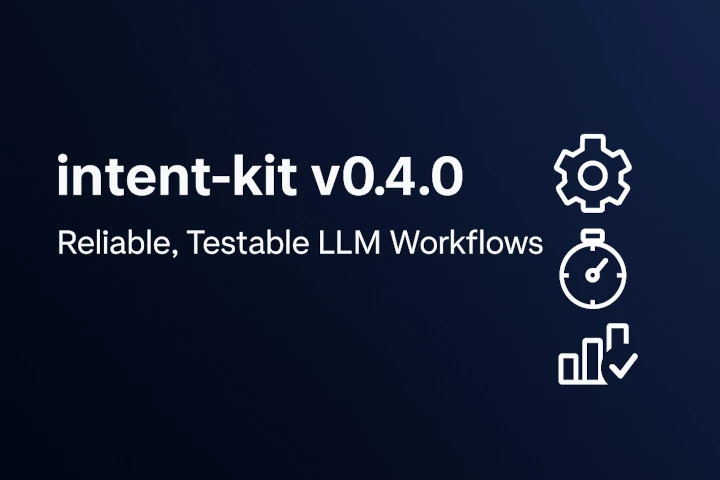intent-kit v0.4.0: Lessons in Reliable, Testable LLM Workflow Engineering


Key Points
Why is it recommended to use environment variables for configuration instead of hard-coding values?
Using environment variables separates configuration from code, making deployments more secure and adaptable across environments like development, testing, and production. This reduces the risk of credential leaks and supports best practices for cloud, CI/CD, and containerized setups.
How does the new PerfUtil utility improve workflow performance in intent-kit v0.4.0?
PerfUtil enables users to track the runtime of workflow steps or actions, helping identify bottlenecks and optimize performance. This early performance monitoring makes it easier to maintain predictable and efficient workflows as complexity grows.
What benefit does introducing a NodeType enum provide in workflow automation systems?
Using a NodeType enum replaces error-prone string identifiers with explicit types, reducing bugs from typos and making the code easier to read and maintain. It also allows development tools to catch mistakes, improving overall reliability.
Why is comprehensive testing of ActionNode important in the context of intent-kit?
Thorough testing of ActionNode clarifies expected behavior and ensures that changes or new features don't break existing functionality. It also gives contributors the confidence to improve or extend the system while keeping edge cases under control.
How do pre-commit hooks and test coverage tools contribute to project maintainability?
Pre-commit hooks enforce consistency in changelogs and versioning, while coverage tools like CodeCov highlight untested parts of the code. These practices help prevent errors, reduce technical debt, and make it easier for new contributors to understand and work on the project.
intent-kit v0.4.0: Key Concepts and Lessons from This Release
The latest intent-kit release (v0.4.0) is a good opportunity to highlight a few patterns and practices that make LLM-driven systems more robust and maintainable. Here’s a look at the most relevant improvements and why they matter if you’re building or maintaining workflow automation around large language models.
Environment Variable Support for Configuration
Hard-coding API keys and model settings is a common early mistake. By supporting environment variables for LLM config, intent-kit now encourages a best practice: separating configuration from code.
Why this matters:
- Makes local/dev/test/prod separation clean and secure
- Reduces the risk of accidental credential leaks
- Enables “12-factor app” style deployment, where code is portable and config lives outside the repo
If you’re working in any kind of cloud, CI/CD, or containerized setup, environment variable config is almost always the right move.
Performance Monitoring with PerfUtil
If you chain together LLM calls or complex workflows, performance can quickly become unpredictable.
PerfUtil is a small utility added in this release that lets you track how long nodes or actions take to run.
Why it matters:
- Pinpoints slow steps or bottlenecks
- Helps with profiling and optimization
- Makes it easier to set expectations for user-facing latency
A lesson here: Add performance hooks early. Even a lightweight timer pays off when things get complex.
Stronger Type Safety with NodeType Enum
Workflows built as graphs or trees are prone to “stringly-typed” bugs—where node types are just strings passed around.
By introducing a NodeType enum, intent-kit shifts toward explicit, predictable node handling.
Why this matters:
- Reduces silent failures from typos or refactoring
- Lets your IDE catch mistakes
- Makes the codebase more self-documenting
If you’re designing your own workflow engine, prefer enums (or constants) for node kinds rather than freeform strings.
Comprehensive Testing for ActionNode
Automated tests for the core node—ActionNode—were expanded in v0.4.0.
Why this matters:
- Tests clarify how the node is supposed to behave
- New contributors can make changes with confidence
- Edge cases are less likely to break your system later
Lesson: Write tests for the real “workhorse” objects in your system, especially those representing actions or state transitions.
Dev Hygiene: Pre-commit Hooks, Coverage, and Cleanups
Little things add up:
- Pre-commit hooks help keep your changelog and versions consistent
- CodeCov integration lets everyone see where tests are lacking
- Cleaning out unused dependencies avoids bitrot
If your project is growing, investing in these practices saves time and confusion for both you and your future contributors.
Summary:
Intent-kit v0.4.0 bakes in practices that any modern Python/LLM project should consider: secure config, performance hooks, type safety, targeted tests, and dev workflow automation. Each is small on its own, but together they add up to a codebase that’s much easier to reason about, extend, and trust.
Want to see these ideas in action? Check out the code or try running a workflow with the new release.
Any and all feedback is welcome!